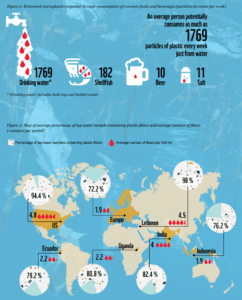Pollution from Plastic Microfibers… At Dinner, Credit Card
Storytelling that distracts from solving the problem
This evening and regularly for one evening a week, at dinner will be served... a credit card!! Yes!...you understood correctly, you will sit at the table and feed yourself with a credit card.
The immediate refusal of this proposal must not hide the fact that every day we unknowingly suffer a part of this gesture, the causes of which are our absolute responsibility.

A WWF study commissioned by Newcastle University, (SIDNEY) , “No Plastic in Nature: Assessing Plastic Ingestion from Nature to People” , coordinating 50 previous field studies, has determined that there are around 2000 tiny fragments of plastic that we ingest every week.
These are mostly plastic microfibers under 5 millimeters, ingested, most of the time through water. 35/40% of microplastics come from the use and washing of synthetic fabrics and padding . 260 grams per year is the amount of plastic microfibers that enter our body: a medium-sized apple... an apple of juicy Plastic.
The WWF's position
WWF calls, for the umpteenth time, on governments to implement policies aimed at a drastic reduction in the use of plastic . If until a few years ago it was not clear whether and how these microfibers would enter the food chain, it is now evident and established that this aspect is now outdated and we must unfortunately focus on the dangerousness and extreme toxicity of these fibers , once they have penetrated the human body.
Global policies aimed at reducing plastic microfibers are, also due to the economic interests at stake, absolutely difficult to plan and implement, therefore, the fundamental appeal and alarm of the WWF is addressed to each of us, to our behavior, to our environmental and health sensitivity, to our purchasing decisions.
Let's take for example the choice of purchasing a piece of clothing, an accessory, a padded home textile product. Sustainability , reuse , recycling , upcycling ... Are we sure that the storytelling of recycling and the alleged sustainability that regularly invades our days corresponds to an effective ethical attention to the problem of pollution and health?
Are we sure that directing our purchasing choices towards garments and padding advertised as eco-friendly , only because they use recycled fibres, derived from plastic from disused bottles or any other plastic residue, responds to the request and problem repeatedly raised by WWF and/or countless other associations? Does it respond to a more general health problem?
Or more likely, a yarn, a fabric, a padding, any product produced with waste materials that are certainly harmful to our health, maintains this dangerousness unchanged, even increasing it because in order to reuse it, this material is subjected to "stressful" processes, causing the loss of its primary cohesion, resulting in it being more easily dispersed in the environment ?
What are we sure of?
What are we willing to risk?
Who are we willing to follow?
Nature feeds on nature, not marketing. Natural fibers and Silk in particular, natural because the fiber is natural and sustainable and the complex production process is natural , represent the TRUE path to take to seriously limit the presence of plastic microfibers in the environment and in humans. Silk also contains enormous potential and technical, physiological and performance characteristics that certainly make it not only the fiber but the material of the future .
When will we understand?
Waiting…
Bon appetit humanity!
A credit card a week to reset our credit with nature...and with ourselves!!!






























































































